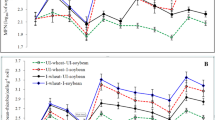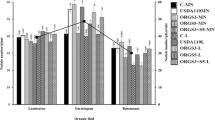Abstract
Competitive abilities of 3 strains ofBradyrhizobium japonicum (E104, E109, E110) for nodulation of soybean (Glycine max) at increasing nitrogen fertilizer levels were studied. Dry weight of plants nodulated by strain E110 were depressed at 10 g N·m−2, the highest fertilizer level, even when mixed with strain E109. Strain E104 alone or mixed with E109 increased dry matter production. Strain E110 formed many dually infected nodules with strain E104 present but not with strain E109. However, strain E104 formed nodules containing strain E109. Neither strain E110 or E109 produced bacteriocin, so the incompatibility of these two strains had to be due to another reason. Strain E104 successfully competes with strain E109 but not with E110 at 10 g N·m−2. It is concluded that strain E110 dominates the symbiotic relationships even if other strains are also present in the nodules. However, at a high N-fertilizer level strain E110 decreases the plant yield in contrast to E104, which could be recommended as inoculant at increased levels of soluble soil-N.
Similar content being viewed by others
References
Allison F E and Ludwig C A 1934 The cause of decreased nodule formation on legumes supplied with abundant combined nitrogen. Soil Sci. 37, 431–443.
Atkinson C A 1986 The legume/Rhizobium symbiosis: limitations to maximising nitrogen fixation. Outl. Agric. 15, 128–134.
Beringer J E 1974 R factor transfer inRhizobium leguminosarum. J. Gen. Microbiol. 84, 188–198.
Brockwell J, Roughley R J and Herridge D F 1987 Population dynamics ofRhizobium japonicum strains used to inoculate three successive crops of soybean. Aust. J. Agric. Res. 38, 61–74.
Brown C M and Dilworth M J 1975 Ammonia assimilation by Rhizobium cultures and bacteroids. J. Gen. Microbiol. 86, 39–48.
Dazzo F B, Hollingworth R I, Sherwood J E, Abe M, Hrabak E M, Gardiol A E, Pankratz H S, Smith K B and Yang H 1985 Recognition and infection of clover root hairs byRhizobium trifolii.In Nitrogen Fixation Research Progress. Proc. 6th Interntl. Symp. Nitrogen Fixation, Corvallis, OR 97331, August 4–10, 1985. Eds. H J Evans, P J Bottomley and W E Newton. pp 239–245. Martinus Nijhoff Publishers, Dordrecht, The Netherlands.
Dowling D N and Broughton W J 1986 Competition for nodulation of legumes. Annu. Rev. Microbiol. 40, 131–157.
Ellis W R, Ham G E and Schmidt E L 1984 Persistence and recovery ofRhizobium japonicum inoculum in a field soil. Agron. J. 76, 573–576.
Fåhreaus G 1957 The infection of clover root hairs by nodule bacteria studied by a simple glass slide technique. J. Gen. Microbiol. 16, 374–381.
Gibson A H and Pagan J D 1977 Nitrate effects on the nodulation of legumes inoculated with nitrate reductase-deficient mutants of Rhizobium. Planta 134, 17–22.
Hirsch P 1979 Plasmid-determined bacteriocin production byRhizobium leguminosarum. J. Gen. Microbiol. 113, 219–228.
Kosslak R M and Bohlool B B 1985 Influence of environmental factors on interstrain competition inRhizobium japonicum. Appl. Environm. Microbiol. 49, 1128–1133.
Mårtensson A M, Gustafsson J-G and Ljunggren H D 1984 A modified highly sensitive enzyme-linked immunosorbent assay (ELISA) forRhizobium meliloti strain identification. J. Gen. Microbiol. 130, 247–253.
McNeil D 1982 Variation in ability ofRhizobium japonicum strains to nodulate soybeans and maintain fixation in the presence of nitrate. Appl. Environm. Microbiol. 44, 647–652.
Moawad H A, Ellis W R and Schmidt E L 1984 Rhizosphere response as a factor in competition among three serogroups of indigenousRhizobium japonicum for nodulation of field-grown soybeans. Appl. Environm. Microbiol. 47, 607–612.
Moawad M and Schmidt E L 1987 Occurrence and nature of mixed infections in nodules of field-grown soybeans (Glycine max). Biol. Fertil. Soils. 5, 112–114.
Munns D N 1977 Mineral nutrition and the legume symbiosis.In A Treatise of Dinitrogen Fixation IV. Agronomy and Ecology. Eds. R W F Hardy and A H Gibson. pp 353–391. Wiley, New York.
Kosslak R M and Bohlool B B 1985 Influence of environmental factors on interstrain competition inRhizobium japonicum. Appl. Environm. Microbiol. 49, 1128–1133.
Nelson L M 1987 Response ofRhizobium leguminosarum isolates to different forms of inorganic nitrogen during nodule development in pea(Pisum sativum L.). Soil Biol. Biochem. 19, 759–763.
Rennie R J and Dubetz S 1984 Multistrainsvs. single strainRhizobium japonicum inoculants for early maturing (00 and 000) soybean cultivars: N2 fixation quantified by15N isotope dilution. Agron. J. 76, 498–502.
Trinchant J C and Rigaud J 1980 Nitrate inhibition of nitrogenase from soybean bacteroids. Arch. Microbiol. 124, 49–54.
Vincent J M 1970 A Manual for the Practical Study of Root-Nodule Bacteria, IBP Handbook no 15. Blackwell Scientific Publications, Oxford and Edinburgh.
Author information
Authors and Affiliations
Rights and permissions
About this article
Cite this article
Mårtensson, A.M., Brutti, L. & Ljunggren, H. Competition between strains ofBradyrhizobium japonicum for nodulation of soybeans at different nitrogen fertilizer levels. Plant Soil 117, 219–225 (1989). https://doi.org/10.1007/BF02220715
Received:
Revised:
Issue Date:
DOI: https://doi.org/10.1007/BF02220715




